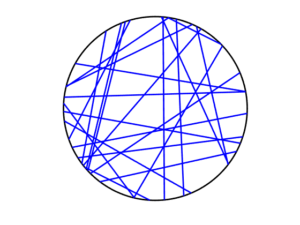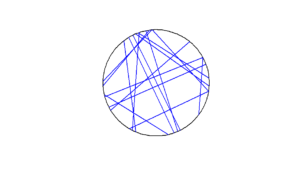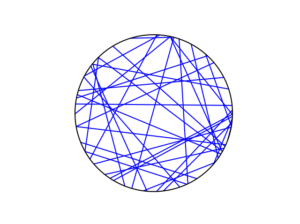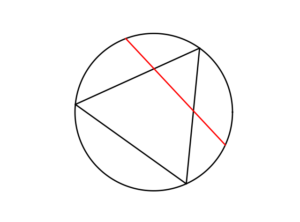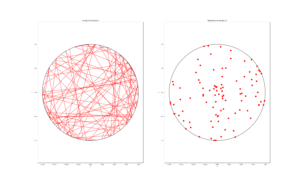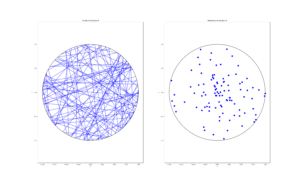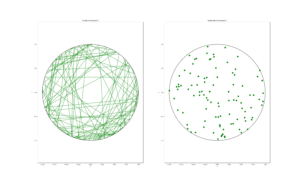I found myself recently wondering who the first author was of a seminal paper that created a mathematical field. I did some online digging and I noted my findings here for others who may ask the same question.
Percolation theory
The 1957 paper by S.R. Broadbent and J.M. Hammersley gave birth to percolation theory. I noticed the author affiliations:
S.R. Broadbent, United Glass Bottle Manufacturers
J.M. Hammersley, United Kingdom Atomic Energy Research Establishment Harwell
I knew John Hammersley’s name already, as he had co-written a classic book on Monte Carlo methods. Indeed, if you look at the end of the paper, you see the paper’s idea was born at an early conference on Monte Carlo methods.
But who was S.R. Broadbent? And what was he doing at a bottle factory?
Probability work
This Broadbent character was a bit mysterious. At first, it seemed as though the writer always published as S.R. Broadbent — so much so, I thought he might be a she. Such things have happened before, as the story behind the influential 1960 paper by A.H. Land and A.G. Doig demonstrated.1Alisa H. Land only died in 2021. Alison G. Doig is still alive but she has been known as Alison Harcourt and has worked as a tutor at the University of Melbourne for many, many years.
From the start I could see S.R. Broadbent was strong in probability. In the 1950s Broadbent wrote probability papers, including a 1953 paper co-written by the British father of stochastic geometry David G. Kendall. 2For those across the La Manche, the French father of stochastic geometry is Georges Matheron. The Broadbent and Kendall paper has the improbable title The Random Walk of Trichostrongylus retortaeformis. (It’s a type of larva.)
And then I was thrown by the title of a paper co-written by Broadbent in the 1960s: A computer assessment of media schedules.
Simon says ley lines are just spatial coincidences
Then I lost track of S.R. Broadbent in terms of academic papers. I had almost given up, assuming Broadbent had left academia. But then I saw Broadbent’s name mentioned in the acknowledgements in a famous spatial statistics paper written by David Kendall in 1989. In the paper Kendalls cites a 1980 paper written by S.R. Broadbent. The subject was the statistics of ley lines — it’s a thing — showing they can be explained by mere chance. And in the acknowledgements Kendall thanks a certain Simon Broadbent — presumably he’s S.R. Broadbent whose paper Kendall cited.
Had I found the S.R. Broadbent? I was a bit skeptical, but then he’s mentioned as Simon Broadbent in this obituary of Hammersley:
Despite the title of the paper, ‘Poor man’s Monte Carlo’, the lasting contributions are the clear statement of the problem of counting self-avoiding walks, the use of subadditivity to prove the existence of the connective constant, and the discussion of random media that culminated in Simon Broadbent’s formulation of the percolation model.
That reassured me.
And then I found two 1950s papers (1954 and 1958) by a Simon Broadbent, not S.R. Broadbent, published in the Journal of the Royal Statistical Society Series C: Applied Statistics. I had actually stumbled upon the 1958 paper earlier in my searches. Initially I didn’t think it was S.R. Broadbent because the journal referred to the author as Dr Simon Broadbent, and I thought only medical doctors do that to each other. But it’s a statistics journal. So it’s probably S.R. Broadbent. Also, for this 1954 paper in the same journal they call him Mr Simon Broadbent.
And then I looked at the paper by Broadbent that David Kendall cited, and in that paper Broadbent acknowledges Kendall. And then I noticed that this paper was actually written by Simon Broadbent, but Kendall had cited the paper and written its author as S.R. Broadbent. The final link. S.R. Broadbent was Simon Broadbent — whoever that was.
I thought I had come to the end. But I hadn’t.
Advertising guru
A non-scientific article had floated up in my search results talking about the death of some big name in advertising. Seeing the title and reading the start, I thought it couldn’t be the same Simon Broadbent.
Simon asked simple questions: How does advertising work? How much advertising is enough? How can we tell whether our ad campaign has succeeded? Is adspend profitable?
When he entered advertising in the 60s, none of these questions had satisfactory answers. Many doubted they could ever be answered. Simon did more than anyone to show that advertising can contribute to profit, and that it is not a cost that can be cut with no effect on sales.
But after reading more, I realized this had to be the very same Broadbent.
He answered advertising questions with the rigour of a mathematician and the clarity of a poet. He read engineering at Cambridge, took an applauded first in mathematics and a diploma in statistics at Magdalen, Oxford, and completed his doctorate in statistics at Imperial, London. His poetry was published by Blackwell’s while he was still an undergraduate.
His lifelong interest was applying statistics to problems that nobody had thought amenable to statistical analysis. His paper to the Royal Statistical Society, In Search of the Ley Hunter, debunked claims for the existence of megalithic ley lines, pointing out that there were fewer alleged lines than would be expected from a random distribution of points between which lines could be drawn. Preparing the paper also allowed him to crawl about in Greenwich Park, testing the likely accuracy of stone-age surveying devices using instruments he had built himself.
Simon R. Broadbent made quite the impression in advertising, even being called a global legend in media research. Some of his contributions to this field are mentioned in this published tribute. It seems this field remembered him better than his original field. I couldn’t find any tributes focusing on his mathematical contributions.
Mystery solved, except for what the R stands for.
Back to percolation
Now knowing the S stood for Simon, I noticed that Simon Broadbent is mentioned in the Wikipedia article on percolation theory. The article cites a tutorial article by John Hammersley and Dominic Welsh, which gives the original motivation of percolation theory:
The study of percolation originated from a question posed to one of us by S. R. Broadbent (see Hammersley and Morton 1954). Broadbent was at that time working at the British Coal Utilization Research Association on the design of gas masks for use in coal mines. These masks contained porous carbon granules (the medium) into which gas (the fluid) could penetrate. The pores in a granule constituted a random network of tiny interconnecting tunnels, into which the gas could move by surface adsorption; and the question was what properties of such a random network would assist or inhibit the uptake of gas. If the pores were large enough and richly enough connected, the gas could permeate the interior of a granule; but if the pores were too small or inadequately connected, the gas could not get beyond the outer surface of a granule. Thus there was a critical point, above which the mask worked well and below which it was ineffective. Critical phenomena of this sort are typical of percolation processes, and do not, normally arise in ordinary diffusion.
The original Broadbent and Hammersley paper did mention that Broadbent had previously worked at British Coal Utilisation Research Association (BCURA).
(Another aside, the same Wikipedia article says Rosalind Franklin, whose X-ray work helped reveal the structure of DNA, also worked on porous material at the British Coal Utilisation Research Association, before leaving in 1946, which I guess was before Broadbent started working there. You can read about her career, for example, here.)
Summary
Simon R. Broadbent was a trained engineer and mathematician who co-founded the thriving mathematical discipline of percolation theory, before leaving that world to go revolutionize the field of advertising by using quantitative methods and writing influential books.


